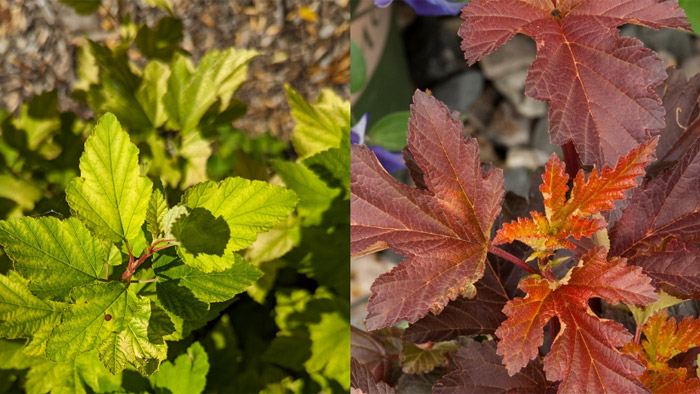I remember the first time I saw a purple shrub I was somewhere between confused and impressed. How different! How unique! Now I can hardly help a customer design their yard without recommending a purple option in the mix for colour contrast.
There are a few different species that grow with purple foliage, but the most resilient of all are Ninebarks. The Center Glow Ninebark is a long-standing classic among all the ninebarks we carry. Its brick red to maroon foliage is of course its main selling feature but with a flare of green in the center of the new leaves in spring time. At its full mature size, Center Glow grows to be 6′ tall and wide. Ninebarks handle pruning well and can be maintained at a smaller size with consistent sheering.
While Ninebarks are best known as the “purple plant” they are also equally useful for contrast on the opposite end of the scale. Dart’s Gold Ninebark has bright, yellow foliage that contrasts powerfully with the reddish foliage of Center Glow. It also grows to a full height of 6′ tall and wide and is equally cold tolerant.
Ninebarks are also quite soil tolerant. They are not very picky about what kind of soil they are planted in so long as they have good drainage. They will struggle in a low soggy area, and are actually fairly drought tolerant once established. That being said it is still important to make sure your Ninebarks are being watered consistently, especially in spring when the fresh growth begins. I have seen ninebarks grow fresh shoots from the root that were over 2′ long in a matter of weeks. Vigorous growth is a strong trait of the ninebarks but the tender new growth is prone to dehydration. The tips of these shoots will begin to hang like a candy cane if they become dehydrated. If watered quickly, there will be no lasting damage, but if the water comes too late the new growth will become scorched. This vigorous growth also requires regular pruning at least once if not twice a year to help maintain shape and structure.
A key factor to remember with colourful plants is that the more sunlight they have the better the colour will become. A ninebark planted in a low light area will grow slower and fade back to green. Ninebarks can suffer from powdery mildew if planted in such a place so make sure they stay in the open sun, and away from sprinklers. Being in the full sun and with adequate air movement will prevent powdery mildew. Ninebarks are also known for holding onto their foliage late into the fall and into winter giving interest for a little longer than most shrubs.
Whether you need just one bush, a pop of colour, something quick growing or even a full hedge, ninebarks remain a popular and likely option for your yard.




